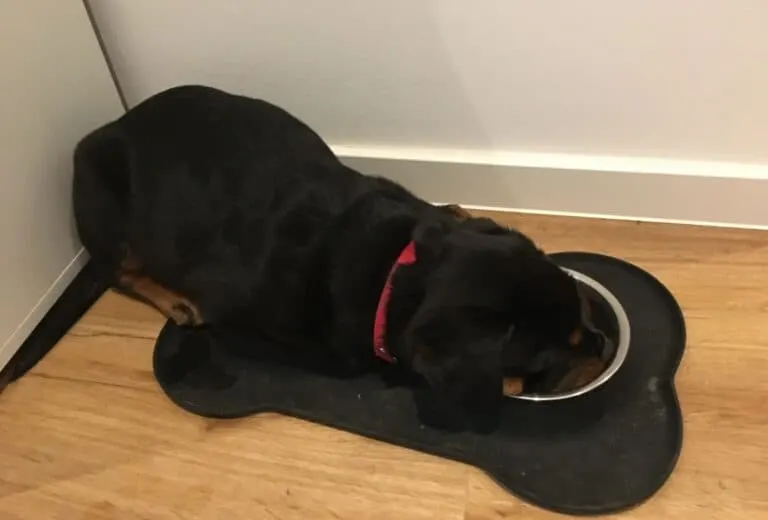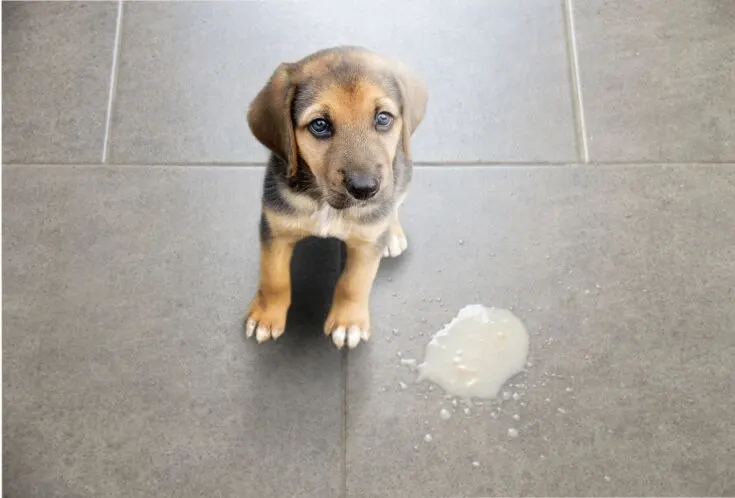The pros and cons of feeding their dog once a day have been debated by many pet owners.
It’s true, I joined them and initiated “intermittent fasting” for my 100-pound Rottweiler.
Just so you know, the scientific community is still debating whether or not a once-daily feeding schedule is best. There are a few studies, but no published, large-scale ones that have been examined by experts in the field.
However, not all dogs are capable of learning new tricks.
An obvious red flag that a once-daily feeding plan isn’t ideal for your dog is persistent vomiting.
When the time passed between meals, my Rottweiler would occasionally throw up (then again, she always did love her food and rarely left a crump in her bowl).

Some dog owners, however, claim that their pets have greatly improved after fasting.
You and your vet should decide if your dog is healthy enough for the procedure.
On the other hand, an adult dog of a large breed in good health might enjoy it and be able to do just fine with it.
But if you have a puppy, an older little dog, or a dog that isn’t fit, you may need to rethink the timetable and keep to feeding 2-3x each day.
Let’s have a look at how you may figure out if it’s worth it for you to attempt feeding your dog once a day.
Do You Think It’s Cruel to Only Give Your Dog Daily Meals?
In most cases, feeding a healthy adult dog once a day is not cruel, provided that the meal is of sufficient size and nutritional composition. Not all canines thrive on a once-daily feeding schedule, so it’s crucial to notice any problems early on.
Whether or not your dog can get by on a once-daily feeding schedule depends largely on how old he or she is.
Because of their rapid growth and development, puppies can’t get the nutrients they require by eating just once (or even twice) a day.
In the first place, your dog won’t be able to finish the full food in one sitting.
Second, your puppy won’t have the recharging time between naps that’s typical for young dogs.
A senior dog may struggle with a once-daily feeding schedule since he will have less energy throughout the day and will be unable to digest a substantial meal.
A dog’s preexisting health issues are treated the same way.
If you’re unsure, feeding your dog twice daily is probably fine; however, you should check with your vet first.
Feeding your dog once a day is not recommended if any of the following is true:
- The dog is either very old or very sick.
- Congratulations, you’ve just gotten a puppy! (needs feeding 3-4x per day)
- Multiple consecutive days of once-daily feeding have occurred.
- One meal a day is too much for your dog (vomiting, lethargic, gut issues)
But for those who are curious about trying out once-a-day feeding, or who may have tried it in the past due to time constraints, let’s delve more into the pros and cons.
Examining the Benefits and Drawbacks of a Daily Dog Meal
Some owners of dogs who are fed once daily report an increase in their pet’s appetite and a positive impact on their dog’s gastrointestinal or immune health, but this practice is not without significant drawbacks.
When other dogs vomit, it’s just white foam (the vomit color is actually essential to check the reason for the vomiting).

Firstly, the pros of feeding your dog once a day:
- Improved gut health
- Stronger immune system
- More interest in eating the rest of the week
- Less risk for bloating, especially on busy days
- Resembles feeding pattern of wolves
- More convenient for dog owner
As was indicated above, there is some dispute about the efficacy of improving gut health and the immune system.
However, because this feeding pattern is far more comparable to what they’d do in the wild, it may have a beneficial effect on your dog’s gut health.
Alternatively, one could argue that dogs are not wolves anymore and that their diets have changed significantly due to domestication.
The caloric needs of your dog may not decrease during a fast, but intermittent fasting can still have a beneficial effect even if the weekly nutritional supply remains the same.
Many people who are attempting to reduce weight have found success with this method, and it can be just as helpful for overweight pets.
You shouldn’t overdo it by feeding more all at once than you normally would during the day.
Even twice a day, some pet owners abstain from feeding their dogs.
I could never go without food for two days, and if I were to fast my Rottweiler, I’d make sure she got anything besides raw meat (still the benefit of having a reset for her gut).
That’s fine and fantastic, but it’s important to keep in mind that there could also be drawbacks.
The cons of feeding your dog once a day are the following:
- Lack of nutritional balance for prolonged time
- Vomiting can lead to other health issues
- Dog might not be able to eat the whole meal (or will wolf it down too quickly)
- Can create confusion around the feeding schedule
There are simple ways to address some of these problems, such as maintaining a healthy diet and finishing one’s meal.
If your dog appears to be eating normally while you’re keeping tabs on him, then he’s probably fine (might still not be the best solution for you though).
However, vomiting is more difficult to manage, so you should keep a close eye on your pet and see a vet if it persists after the initial adjustment period.
Lastly, your dog will likely be perplexed.
Just imagine: you have no idea what’s going on and you go a full day without eating. When do we get to eat again? Will you go hungry? Have we forgotten about you?
If I miss even one meal, my Rottweiler’s eyes tell me he’s not happy.
Also, while I’m traveling with my dog, there are times when we don’t have enough time to stop for two meals.

I don’t just mean giving her enough time for her to eat in peace and quiet and relax thereafter.
If you absolutely must exercise your dog soon after eating, I recommend going without food or giving a very small, light meal to reduce the risk of bloat.
Once Daily Dog Feeding: When Is It Best To Do It?
Your dog should be fed once daily, preferably in the morning or evening, but you can also spread out the time between meals by feeding it in the middle of the day. The optimal feeding schedule is 12 hours between meals.
Before and after the once-a-day feeding, this plan implies that you’ve been feeding your dog twice daily.
If you only want to feed your dog once per day, pick a consistent time, like noon, and stick to it.
A couple of examples:
- You feed your dog 8pm on Monday, then 8am on a Tuesday morning, and again 8am on Wednesday morning
- You feed your dog 8pm Mon, then 8pm Tue, and 8am Wed
- You feed your dog 8pm Mon, then 2pm Tue, and 8am Wed
- If you feed once a day, stick to 2pm every day, for example
The particular feeding regimen for your dog will vary greatly.
Not everyone can afford to feed their dog in the middle of the day, so you should schedule your morning and evening meals accordingly based on when you normally go to bed and wake up.
How Often Should I Feed My Dog, If At All
Yes, you can feed your dog three times a day; in fact, this is the preferred feeding plan for puppies, senior dogs, and dogs with certain health concerns.
If your adult dog thrives on that schedule, you can continue to do so even if your dog is otherwise healthy.
Some dogs cannot go all day without eating, so I’ve been giving my Rottweiler a snack around noon to prevent the dreaded stomach growl.
Be wary of giving your pet a huge meal in the middle of the day because of the possibility of bloat.
Don’t give in to the cuteness and feed them a third meal if it’s not required. In particular, if it’s an extra meal.
When to Feed Your Dog for the Best Results
Feeding your dog at the optimal time is dependent on how often you feed it; nevertheless, meal intervals should be kept to no more than 12-24 hours.
The above-mentioned feeding schedules can serve as a guide.
The best times to feed a dog are first thing in the morning and before bed.
Be careful to let your dog out at least an hour before bedtime to avoid accidents.
Should Your Dog Be Fed Before or After Walks?
For optimal digestion, try to wait at least an hour after feeding your dog before taking it for a walk, and give it some time to rest and relax afterward.
Personally, I think it’s best to feed your dog after a walk rather than before, due to the increased risk of bloat and other problems associated with feeding before walks.
Schedule Alterations for Dogs: How to Do It
Each adjustment to the diet, including the feeding schedule, should be made gradually and under strict observation. If your dog isn’t doing well, slow down for a while.
Suddenly reducing your dog’s daily food intake from three to one could result in nausea, vomiting, and other digestive issues.
Instead of feeding your dog once a day, try feeding it twice a day, with the lighter meal coming after your dog has adjusted (which could take many days or weeks).
In time, you’ll be able to reduce your child’s feedings to once per day, with a snack replacing the second meal.
It is up to you to decide if feeding your dog once a day is best, and if you have any doubts, you should talk to your vet.
As long as your dog has plenty of everything he needs, a balanced diet is not cruel. However, scientists is divided on this issue.
My Rottweiler would not tolerate it, and maybe your dog would give you clues as to when he eats best.